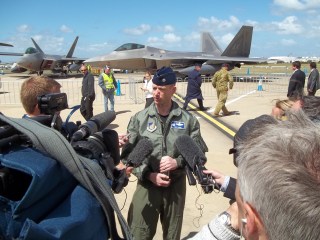At $358 million a copy, it’s fairly easy to find folks in the Pentagon critical of the value-added of the Air Force’s F-22 fighter. It’s a little tougher to find someone in the Air Force to take on the $67 billion program. Really tough to find a fighter pilot willing to do so.
So Lieutenant Colonel – and not only an F-22 pilot, but an F-22 test pilot, and F-22 squadron commander – Christopher Niemi will be raising eyebrows with his precision-guided fire against the F-22 Raptor in the latest issue of the Air Force’s own Air & Space Power Journal. It’s a gutsy, clear-eyed piece. He doesn’t disparage his plane so much as the way the Air Force created it.
Niemi was one of the first 10 Air Force pilots tapped to fly the fifth-generation fighter on Dec. 11, 2001, two months after 9/11. “When there are only 10 pilots in the entire Air Force that get selected for a chance like this, there has to be luck involved,” he said at the time.

Niemi talks to reporters during his F-22 unit’s visit to Australia in March 2011.
Last year in Australia, he touted his plane’s prowess. “Where you really get a sense of speed is when you’re dogfighting in close,” Niemi said during a visit Down Under from his Alaska base. “That’s when you really get a sense of the privilege you have in flying the airplane.”
But Niemi makes clear in his 30-page article that he believes the Air Force blew it when the foe the F-22 was designed to fight – the Soviet Union – disappeared. Instead of retooling the fighter for a changed world, the Air Force – led by fighter pilots from 1982 to 2008 – stuck to its plans for a hyper-sophisticated stealthy war machine, albeit one without an enemy to fight. It has seen no action in the wars in Afghanistan, Iraq or Libya. Niemi notes:
The ATF’s [the Advanced Tactical Fighter, the F-22’s original designation] overly-specialized design constituted a fundamental flaw in the uncertain post–Cold War environment. The Air Force subsequently missed the best opportunity to adapt the F-22 when it issued the EMD [engineering, manufacturing, and development] contract without modification to ATF requirements.
That, Niemi argues, has been a costly mistake. It led the service to sacrifice needed funds to replace its A-10, F-15E and F-16 aircraft on the F-22’s altar. Now the F-35 – designed to replace those three planes – is in deep trouble:
Despite massive cost overruns and schedule delays, the Air Force continues to hope that the F-35 can solely recapitalize 1,770 aging F-15Es, F-16s, and A-10s. However, continuing developmental problems and the emerging national fiscal crisis threaten to undermine this strategy.
Stealth – the ability of an aircraft to elude enemy radar – is a good attribute. But it should be more of a spice — perhaps even a side dish — and not the entire meal, Niemi suggests:
Although stealth is a powerful enabler for offensive systems, its greatest advantage lies in its ability to dramatically increase aircraft survivability against radar-dependent threats. Consequently, stealth’s utility depends on the presence of those threats. By insisting on acquiring only stealth fighters (regardless of the cost), the Air Force assumes that future adversaries will not counter stealth technology and ignores the fact that many air combat operations continue to occur in low-threat environments. For example, allied fourth-generation fighters operated freely over large portions of Iraq (both in 1991 and 2003), Serbia, and Libya from the beginning of those conflicts.
Niemi’s bottom line is simple: the Air Force’s push for an all-stealth F-22 and F-35 fleet is unaffordable, and should be revisited.
Stealth technology demands significant trade-offs in range, security, weapons carriage, sortie generation, and adaptability. Stealth provides no advantage in conflicts such as those in Afghanistan or Iraq (since 2003), and (despite its obvious utility) it cannot guarantee success in future struggles with a near-peer adversary. Most importantly, the cost of F-22s and F-35s threatens to reduce the size of the Air Force’s fielded fighter fleet to dangerously small numbers, particularly in the current fiscal environment. These facts suggest that the Air Force should reconsider its long-standing position that fifth-generation fighters are the only option for recapitalizing its fighter fleet.


